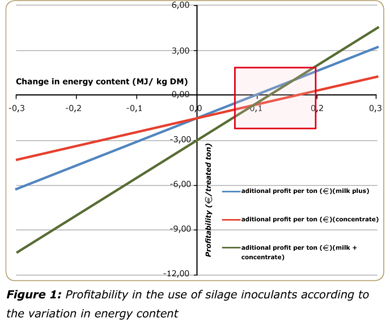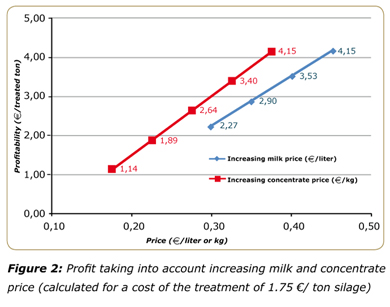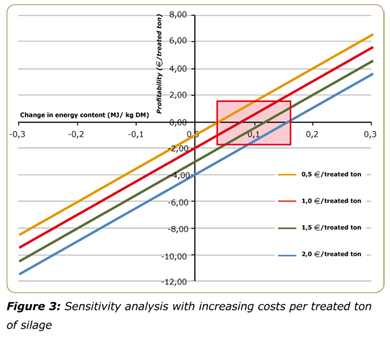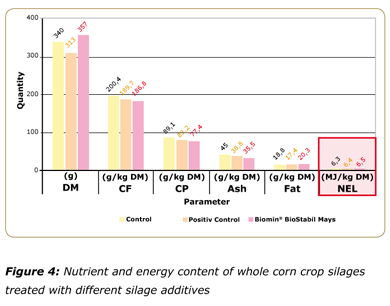Silage Inoculants: Are They Profitable? A Case Study of Wholeplant Corn Silage
In Figure 1 the possible profit obtained with different energy contents compared with non treated silages is shown. The profit is calculated from a higher production of milk, the savings in concentrate and the sum of both(1). The functions become positive (profitability) when the difference between the energy content in treated silage and non-treated silage exceeds around 0.1 MJ/ kg DM. It is also noticeable that an energy loss for a lower energy content than this value (0.1 MJ/ kg DM) would cause financial losses (at the prices for the calculation) of about 3.80 – 5.20 €/ ton silage when the energy content decrease from 0.0 to - 0.1 MJ/ kg DM.

In Figure 2 an analysis taking into account variations in milk or concentrate prices was made. The analysis was conducted only for a cost of 1.75 €/ ton treated silage.

As a logical consequence of the increasing prices, the profitability in the use of silage inoculants increases. When the milk prices ascend from 0.30 to 0.45 €/ liter milk, the increase in the profit caused by the milk increase ranges from 2.27 to 4.15 €/ ton. An increase in the concentrate price per ton (from 175 up to 375 €/ per ton corresponding to 17.5 to 3.75 ¢/ kg) would improve the profitability per ton from 1.14 to 4.15 €. This means, the higher the milk quality (which is possible to reach feeding good silage) and the higher the price of the concentrate (which is increasing markedly nowadays), the better the profitability in the use of silage inoculants.
An important aspect which should be remarked is that the calculations were carried out for 1.75 €/ treated ton, which is relatively high. Lower costs per treated ton of silage would improve these results even more. The following Figure (Figure 3) shows what would happen if the costs per treated ton were to vary. The functions are calculated taking into account the sum of the milk production increase and the savings in concentrate. The differences are always related to silage without treatment or treated with silage inoculants which do not improve the energy content.

It is shown that an energy increase in the silage higher than 0.04 MJ/ kg DM would be already profitable for the producer taking into account the losses/ gains of energy. If the cost per treated ton increases to 2.00 €, the profitability point would be reached only after 0.16 MJ/ kg DM. No changes in the energy content (0.00 MJ/ kg DM) or a decrease of 0.10 MJ/ kg DM would place the economical losses in about 1.00 to 4.00 € and 4.5 to 6.5 € per ton for a cost of treatment of 0.50 and 2.00 €/ treated ton.
A case study of whole-plant corn silage On the basis of knowledge about the factors influencing the silage process and aerobic stability, and as a result of long term research and practical experiences, BIOMIN has developed a product which has recently been taken into account more and more by producers. Its name is Biomin® BioStabil Mays; a unique formula containing homo- as well as heterofermentative bacteria for the ensiling of whole-plant corn, wet corn grains and CCM as well as crops like sorghum forage. Three main actions support the success of the product in farms:
- better fermentation,
- longer aerobic stability and
- higher energy recovery
The laboratory results were corroborated in field trials. An example of the nutrient and energy content using Biomin® BioStabil Mays is shown in the following experiment conducted in Hungary. The treatments were a negative control (without silage additive), a positive control (a competitor product available on the market in the dosage recommended by the producers) and a Biomin® BioStabil Mays treatment. Sub samples of each lot were taken and thoroughly mixed in order to obtain a representative sample (1 kg) of the original material, which was immediately sent to the laboratory. At least six weeks after ensiling, two representative samples, one from each treatment, as a mix of different sub samples, were sent to the laboratory in order to determinate the nutrient variation and the main silage quality parameters.

In spite of a slightly lower crude protein content in the Biomin® BioStabil Mays treatment compared with the negative and the positive control, the energy content of the silage with the tested product was higher compared with the negative control (+0.2 MJ/ kg DM) and positive control (+0.1 MJ/ kg DM). A calculation based on the real values for the three treatments shows (Table 1) an economical advantage for the silage inoculant Biomin® BioStabil Mays. The values of the non treated silage were taken as reference and therefore there is no profit or loss (no investment, no profit). The use of the silage inoculant in the negative control caused an increase of 0.1 MJ/ kg DM (Figure 4) however this energy increase was not enough to cover the investment in the product, neither taking into account the milk production increase (-0.05 €/ ton) nor the saving in concentrate (-0.21 €/ ton). The energy increase (0.2 MJ/ kg DM) in the silage treated with Biomin® BioStabil Mays made a profit of 2.06 and 1.70 €/ ton for milk production increase and saving in concentrate respectively. It would mean a Return on Investment of 1.65 to 3.01 depending on the parameters that will be taken into account.
| Parameter | Unit | Positive Control | Biomin® BioStabil Mays |
| Cost of the treatmenta (A) | € | 150 | 125 |
| Net energy increase in the trialb | MJ | 3130 | 7140 |
| Corresponding milk production increasec | Litre | 414.3 | 945.0 |
| Income per liter of milkd (B) | € | 144.99 | 330.75 |
| Saving in concentratee | kg | 496.8 | 1133.3 |
| Saving in concentratef (C) | € | 129.17 | 294.67 |
| Additional profit [(A + B) – C] | € | 124.17 | 500.42 |
| Additional profit per ton (milk increase) | € | - 0.05 | + 2.06 |
| Additional profit per ton (concentrate) | € | - 0.21 | + 1.70 |
| Additional profit per ton (milk + concentrate) | € | - 0.26 | + 3.75 |
(2): Basic information for the economical evaluation:
a: cost of the treatment for positive control = 1.50; Biomin® BioStabil Mays = 1.25 €/ ton
b: net energy increase in the trial = silage amount (100 TM) x DM content x net energy increase per kg DM
c: corresponding milk production increase = [net energy increase/ net energy per produced liter of milk (6.8 MJ*)] – 10 % losses
d: average prices for milk March 2008 (35.0 ¢/ kg) (ZMP. 2008)
e: commercial concentrate for milk cows (18 % CP) with 6.3 MJ NEL per kg DM
f: average prices for milk cow concentrate
Conclusions
Additives may aid the preservation of forage, but they cannot compensate for poor ensiling practices. Use of an additive should always be associated with good management practices. Ensile always at the correct maturity stage, moisture content and particle length, fill the silo quickly and seal it properly. Following these management practices will improve ensiling and increase the effectiveness of an additive. The effectiveness of the use of a silage inoculant is dependent on the market situation, prices, conditions in the farm, etc. The calculations are an orientation in order to help producers in the decision to use silage inoculants, or in order to estimate the potential profit. The parameter to be taken into account is always the Return on Investment. The product Biomin® BioStabil Mays proved in laboratory as well as in field trials its ability to support the ensiling process in corn and corn related products. The main action of the product is performed in two different ways: the preservation of energy in the silage and the improvement of the aerobic stability due to the higher amount of acetic acid.
For more information please visit www.biomin.net







 BIOMIN Holding GmbH
BIOMIN Holding GmbH +43 2782 803 0
+43 2782 803 0






